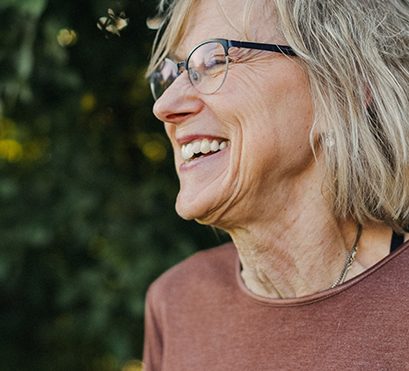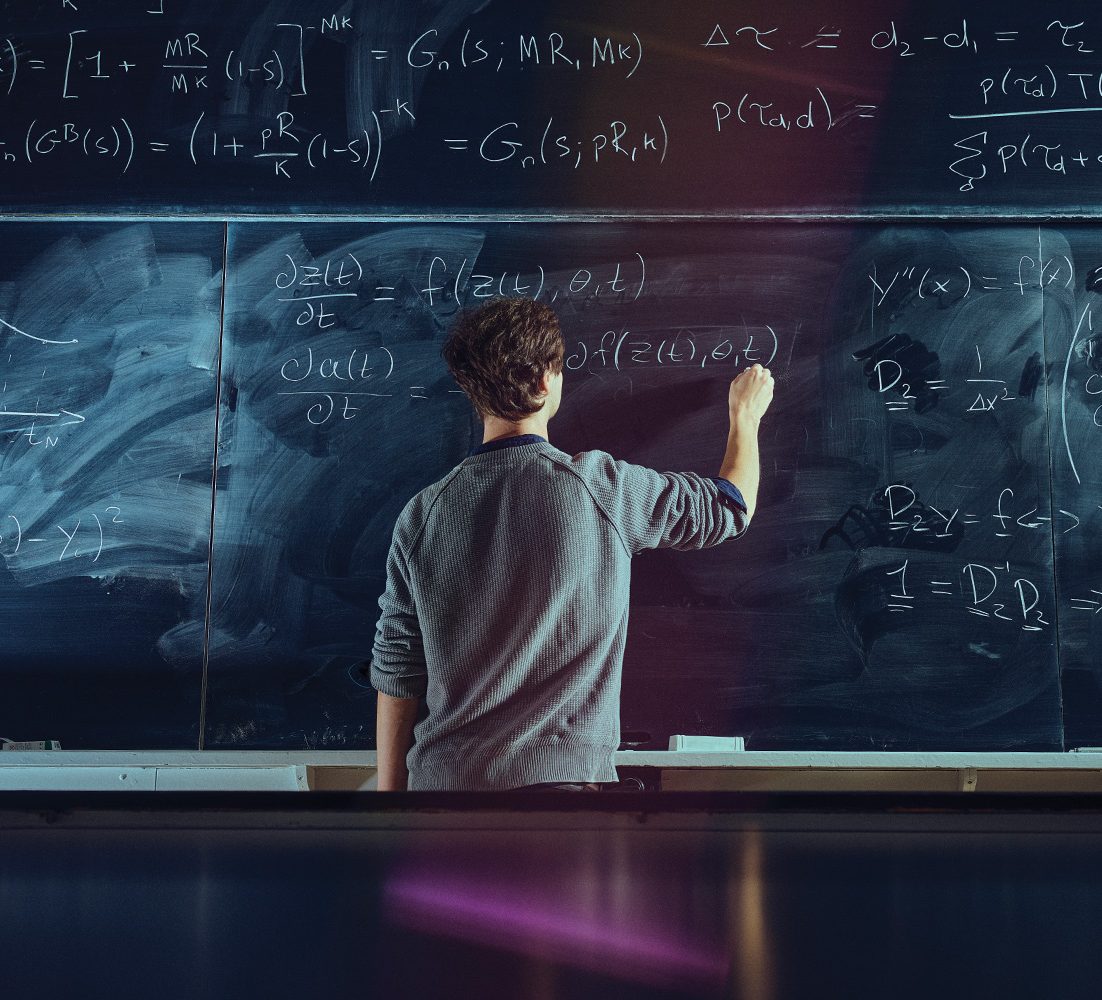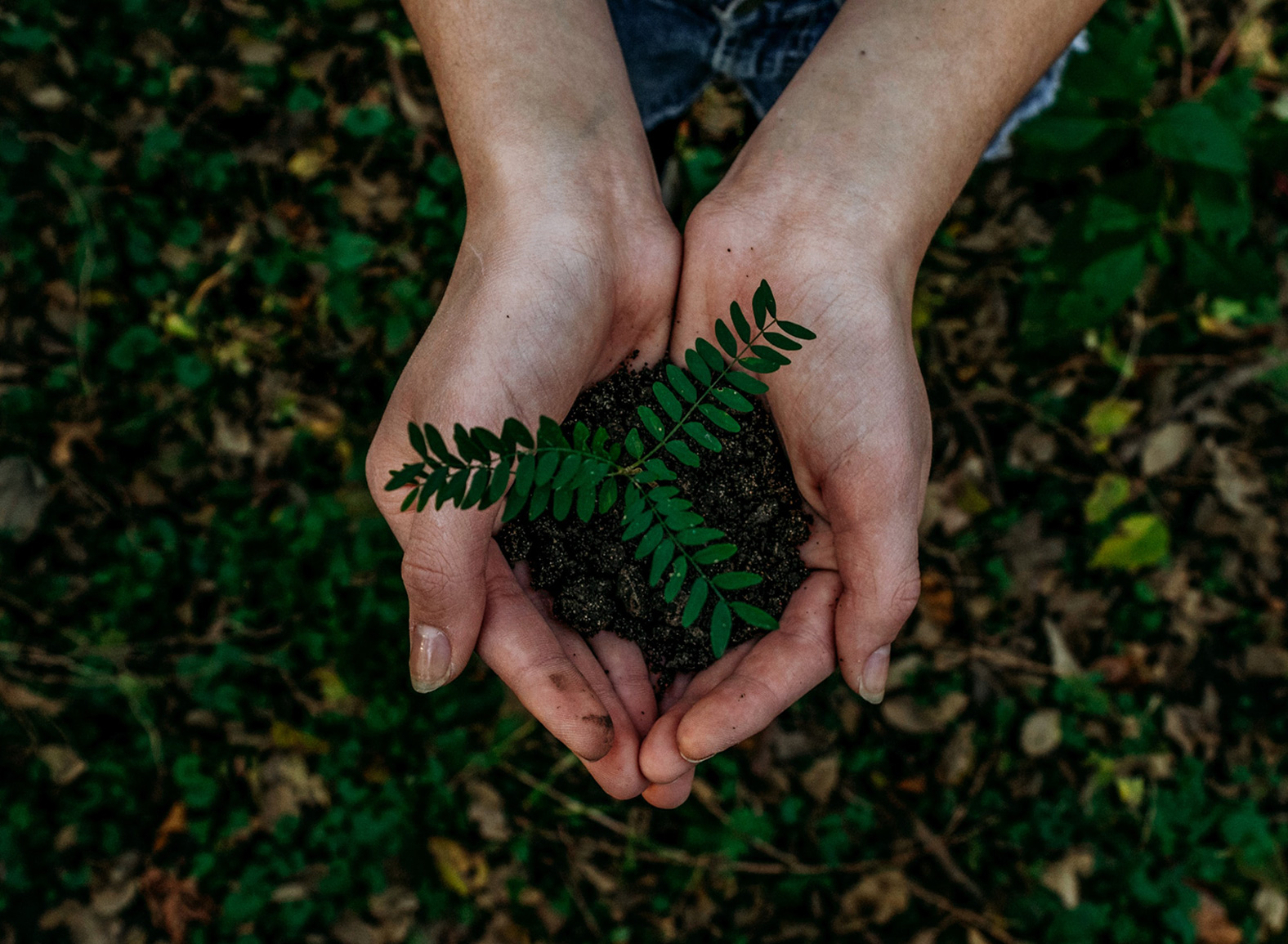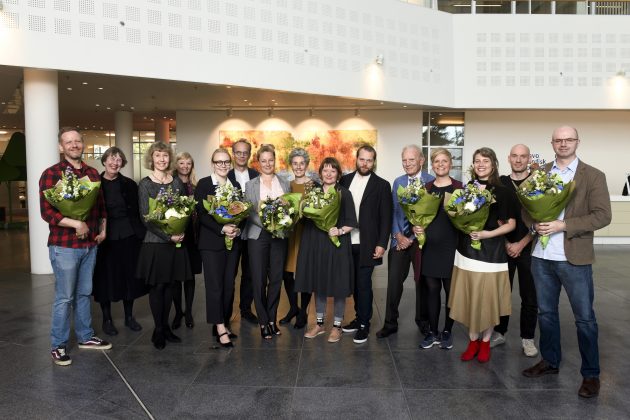This year’s art research grant recipients and their families, friends and collaborators gathered for an inspiring event at the offices of the Novo Nordisk Foundation. The grants were formally awarded to the researchers, who are now embarking on projects including art history topics, practice-based research in art and curating and interdisciplinary research in art and science.
At the end of March, the Foundation awarded five Mads Øvlisen PhD scholarships, four Mads Øvlisen postdoctoral fellowships and two Investigator Grants in art history research.
Jacob Wamberg, the Chair of the Committee on Research in Art and Art History, and Committee members Maria Fabricius Hansen and Mads Øvlisen gave speeches and presented diplomas and flowers to the grant recipients.
”The recipients of the grants are some of the most talented and promising researchers on the Danish art scene and their projects deal with themes that put Danish art research into play on the international stage,” says Jacob Wamberg, Professor and Chair, Novo Nordisk Foundation Committee on Research in Art and Art History.
About 65 guests participated in the event, at which the recipients presented their future research projects. Two recipients who were unable to attend the reception had recorded video presentations about their research, which were shown at the event.
Read more about the researchers and their projects below.
THE 11 GRANT RECIPENTS AND THEIR PROJECTS
Mads Øvlisen PhD Scholarships (5):

Terne Thorsen, cand. mag.
Scholarship: Mads Øvlisen PhD Scholarship – Art History before 1900
Project title: Breaking and Creating – The Contemporary Iconoclasm of Islamic State
Place of research: University of Copenhagen
Abstract: For a long time, neither art historians nor museums dealt with the destruction of art. The past twenty years the attitude towards iconoclasm has changed, and historic iconoclastic events like Babylon, the Reformation and the French Revolution have been studied by art historians and curators alike. Despite of its extensive media coverage, contemporary events like the destruction of cultural heritage by Islamic State (IS) has, however, received sparse attention from art historical research.
Through a case study of IS’s destruction of cultural heritage in Iraq and Syria from 2014 to 2016, this thesis will study the contemporary destruction of art and how we are supposed to react, when it seems like the outrage only encourages further destruction. The thesis addresses the urgent challenges that the acts of destruction present to museums and policy makers.

Jacob Bach Riis, cand. mag.
Scholarship: Mads Øvlisen PhD Scholarship – Art History after 1900
Project title: Life of the corpse
Place of research: Aarhus University
Abstract: As one of the most significant taboos of industrialized modernity, death has been hidden, controlled, sterilized and clinically removed from our sphere of everyday life. Facebook commemoration sites, as well as mourning guides on YouTube, testify that death today is closer connected to our everyday life. The object of death, i.e. the corpse, has been utilized as aesthetic material in works by a field of artists from the 1990s onwards. The field can generally be defined through a focus on stagings of and intimate interactions with the corpse, as well as a preoccupation with marginalized groups such as: HIV/AIDS patients, criminals or refugees, who are reanimated within the works. For the experiencer, the interaction and bodily relation with the corpse constitute a very concrete and tactile experience of otherwise distant political issues. It shows how art can contribute with a fundamentally different and far more bodily way to comprehend a political and ethical set of problems.

Nanna Debois Buhl, visual artist
Scholarship: Mads Øvlisen PhD Scholarship – Practice-based Art
Project title: Sky Studies: Cosmic Code, Images, and Imaginaries
Place of research: University of Copenhagen and The Royal Danish Academy of Fine Arts
Abstract: My PhD project Sky Studies: Cosmic Code, Images, and Imaginaries focuses on explorations of space across astronomical, computational, aesthetic, and futurological realms with the aim of rethinking well-known (hi)stories of space research, and nurturing attentiveness to more complex historical textures.
The aim of the project is to examine the following research questions: Can we, by studying the work of women and other groups omitted in traditional histories of astronomy and space sciences, reach more attentive conceptions of how history happens, and how the future is made? Can we through studies of their work conceive of new ways of thinking about relationships between art, craft, and science; between analogue and digital technologies? Can we conceptualize a history of space which does not just add to earlier histories, but which makes us sensitive not just to who, but to how people (and things) are included and presented? And can such a broadened understanding allow us to imagine different futures?
I will examine these questions through research and a series of artistic experiments that interweave historical references and new scientific studies. Sky Studies will materialize as photographs, films, weavings, installations, writings, and artist’s books. The project thus combines a production of artworks, a thinking through them, and a meta-reflection on what their materials and technologies signify (at different times).

Charlotte Sprogøe, curator
Scholarship: Mads Øvlisen PhD Scholarship – Practice-based Curating
Project title: Exhibition as (Psycho-Aesthetic) Form – and Backdrop as Character
Place of research: Aarhus University and The Royal Danish Academy of Fine Arts
Abstract: The practice-based PhD project ‘Exhibition as Psycho-Aesthetic Form’ will examine the art exhibition as form in itself. Through curatorial research, it will investigate how certain time-based, backdrop including, conceptually complex international contemporary art exhibitions manage to be experienced as formal aesthetic entities in an aesthetic philosophical sense. The project will be housed at the Royal Danish Academy of Fine Arts, and will be affiliated with Aarhus University’s research program ‘Contemporary Aesthetics and Technology’ and MA Curating with principal advisor Jacob Lund.
The PhD will explore the curatorial sensibility as a co-producer of the work experience and ask the questions:
- How can one curatorial create tensions that vitalize the exhibition as a whole in the visitor’s consciousness?
- What aesthetic experiences of the world of life around us unfold in these curatorial practices?
- Does it make sense to talk about a work as isolated from the total installation experience it is part of?

Jenny Gräf Sheppard, MFA, Artist
Scholarship: Mads Øvlisen PhD Scholarship with extraordinary potential – Practice-based Art
Project title: Communicating Vessels: Re-defining Agency through Sounding
Place of research: University of Copenhagen and The Royal Danish Academy of Fine Arts
Abstract: Heard and unheard sounds are a vehicle for communication that establishes a web of interdependencies within our environment offering a potential re-framing of notions of agency.
Communicating Vessels: Re-defining Agency Through Sounding proposes Sounding as a practice and medium for apprehending new forms of agency, ones that will be explored in an experiment within conventional narrative film form.
This research focuses on the body’s ability to apprehend sound through a spectrum of interdependent senses and actors, phenomena that will be researched through a theoretical framework, field research into non-Western perspectives on sound and subjectivity, and collaborative exchanges and interviews with sound artists and scholars.
Drawing from fields of disparate fields of study, the research expands upon the corporeal anthropology of sound, existing concepts of sonic agency, and practices of Deep Listening developed by composer Pauline Oliveros.
Mads Øvlisen Postdoctoral Fellowships (4):

Nicholas Parkinson, Assistant Professor, PhD
Fellowship: Mads Øvlisen Postdoc Fellowship – Art History
Projekttitel: Copenhagen 1888: Den Franske Kunstudstilling
Place of research: Ny Carlsberg Glyptotek
Abstract: My research looks at the 1888 French Art Exhibition [Den Franske Kunstudstilling] in Copenhagen.
Den Franske Kunstudstilling was a groundbreaking event that brought to Danish audiences over 600 artworks by French modernists including Eugène Delacroix and Claude Monet.
Studying correspondence amongst the exhibition’s Danish and French organizers, including Carl Jacobsen, P.S. Krøyer, and Antonin Proust, archived at the Carlsberg Foundation, my research explores how the French Art Exhibition played a pivotal role in establishing Copenhagen as an important center of international modernism at the turn of the century.

Kasper Opstrup Frederiksen, Dr.
Fellowship: Mads Øvlisen Postdoc Fellowship – Art History
Project title: Unexpected Encounters – on Cosmism, Cosmic Consciousness and Cosmopolitics
Place of research: University of Copenhagen
Abstract: My project examines Cosmism as an expanded field through three peer-reviewed articles on, respectively, Russian Cosmism, Cosmic Consciousness and Cosmopolitics which will be rewritten to a monograph.
Cosmism engages with ways of being unlocked by an evolutionary overcoming of the category of the human. What political and cultural futures appear if we change the site of utopian investment so that the human and not the state must be radicalised?
This question will be explored through a series of unexpected encounters between art history, theory and commissioned artworks for a transnational exhibition with a public programme at Den Frie Udstillingsbygning in partnership with Ujazdoski Castle Centre for Contemporary Art and Latvian Centre for Contemporary Art. A workshop around these topics will be co-organised with the University of Copenhagen and the Royal Danish Academy of Fine Arts.
Together, the exhibitions and papers from the workshop will result in a co-edited catalogue/anthology.

Katrine Dirckinck-Holmfeld, PhD
Fellowship: Mads Øvlisen Postdoc Fellowship – Practice-based Art
Project title: Entangled Archives: Cartographies of Critical Fabulations and Repair in the Colonial Archive
Place of research: The Royal Danish Academy of Fine Arts
Abstract: The post-doctoral artistic research project Entangled Archives proposes a platform that brings together a wealth of artistic practices from Ghana, United States Virgin Islands (USVI) and Greenland, to explore how artists create critical fabulations and reparative practices in the colonial archive.
Entangled Archives operates from the hypothesis that the colonial archive is simultaneously an entanglement of overlapping histories and an instrument that disentangled the communities affected by the Danish colonial rule by producing a radical cut between colonized communities and their creative expression.
The aim of Entangled Archives is to build a counter-archive that reconnects voices and practices disentangled by colonialism by setting up four research collaboratoriums between artists and researchers from USVI, Ghana, Greenland and Denmark to collectively explore the affective materialities of the entangled historical archives and form new artistic practices.

Christian Etheridge, Dr.
Fellowship: Mads Øvlisen Postdoc Fellowship – Art and Natural Sciences
Project title: Depictions of the Heavens: The Interface of Science, Religion and Art in Medieval Scandinavia
Place of research: The National Museum of Denmark
Abstract: The cosmos was depicted by medieval artists in a variety of forms. These artists had to supplement the very basic biblical descriptions of the universe with information stemming from scientific manuals. This created many artistic portrayals of the cosmos in the form of images in church art, manuscripts and early printed images.
This project looks at these portrayals of the cosmos in a medieval Scandinavian context during the period 1000-1550. There has been little work on images of the cosmos in medieval Scandinavia and this project will both establish a website database of pictures and publish an illustrated monograph on the subject.
Investigator Grants (2):

Anne Ring Petersen, Associate Professor, Dr.phil., PhD
Grant: Investigator Grant in Art History Research
Project title: Togetherness in Difference: Reimagining identities, communities and histories through art
Place of research: University of Copenhagen
Abstract: Against the backdrop of the increasingly polarised debates on immigration and integration in Europe, this project examines how art contributes to the reimagination of identities and urban and national communities. Adopting the new concept of postmigration, it re-launches migration and sociocultural diversity as a state of normalcy to reopen the debates on the long-term cultural effects of migration. More specifically, it explores how artistic and curatorial practices can negotiate the disagreements and conflicts resulting from the need to tackle ‘togetherness in difference’ and the way these negotiations play out in ‘postmigrant’ public spaces, understood as contested contact zones.
It aims to answer the questions:
How can artworks add new narratives of identity, community and history to the shared spaces and public memories of European nations, particularly Denmark?
How can curating encourage democratic forms of participation and enable differences to be negotiated through critical artistic practices?
Hans Henrik Lohfert Jørgensen, Associate Professor, PhD
Grant: Investigator Grant in Art History Research
Project title: The Bleeding Image and Visual Animation
Place of research: Aarhus University
Abstract: “The Bleeding Image and Visual Animation” investigates what it means that the medieval image was alive, acting as a living entity able to move on its own, to perform bodily functions and to manifest some sort of “personhood”.
Animated as an active “person”, the image might even bleed, shed tears, speak and do things to its spectator. Sometimes, mechanical devices within figures helped them act and perform. In the later Middle Ages, i.e. from the late thirteenth to the early sixteenth century in a Scandinavian context, automatic action figures and animated puppets became an important means to engage viewers and visitors in pilgrimage, rituals, liturgical feasts, plays, entertainment and spectacular public displays held by cities, churches and monasteries.
Not hitherto recognized and appreciated in the Danish material, this pictorial animation is the focus of the project. The point of departure is a bleeding Man of Sorrows in the Bridgettine monastery of Mariager in eastern Jutland.
Further information
Christian Mostrup Scheel, Senior Press Officer, phone: +45 3067 4805, [email protected]








